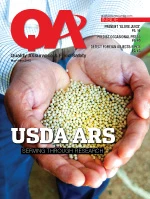Due to the continued lack of movement on publication of the provisions of the Food Safety Modernization Act (FSMA), this Legislative Update takes a look back at the FSMA activities, and lack thereof, during the first half of 2012.
January 4, 2012, was the one-year anniversary of the enactment of the Food Safety Modernization Act. It was also the due date for a number of provisions for which FDA was to have completed an action “not later than one year after the date of enactment.” Included among these were proposed rules for the Produce Safety Regulation (Section 105); Hazard Analysis and Risk-Based Preventive Controls (Section 103); Current Good Manufacturing Practice and Hazard Analysis and Risk-Benefit Preventive Controls for Food for Animals (Section 103); and Foreign Supplier Verification Program (Section 301).
Those rules have not yet been published. However, it is not FDA that is lagging, rather as discussed in a January 6 article by David Acheson, managing director of food and import safety for Leavitt Partners and former FDA commissioner of foods, each of these rules were completed by FDA and submitted to the Office of Management and Budget (OMB) before the January deadline. All four are still pending review by that office.
Even once OMB completes its review and moves the provisions forward, however, there are a number of steps that must be implemented before the rules can take effect. As Acheson noted in May:
- First is the publication of the proposed rule.
- That is followed by a comment period. While typically 60 days, this could be fairly short in this instance to save time, but it is still likely to be at least 30 days.
- Following the comment period, FDA has to weigh all the comments and address them in a final rule, all of which has to happen prior to the effective start date.
- Once the rule becomes effective, it is usual to allow 12 months for large businesses to comply and often three years for small businesses. However, it is not currently clear as to what will constitute a small business in this context.
Additionally, Acheson has noted that is doubtful that FDA will have the resources and funding needed to implement the rules – and this is not likely to change anytime soon. As he stated in the May article, "Some have suggested that if there are no resources, then there will be little enforcement and everyone can continue as usual. This is not a sound approach because FDA will publish the rules, and the law will then require food companies to comply. New enforcement tools like suspension of registration and reinspection fees, along with a lower bar for administrative detention, will make life more uncomfortable for those that are not in compliance with the new requirements. A highway analogy is that the new lower speed limit signs are up but the number of state troopers is the same – however the troopers now can levy much greater penalties on transgressors. A final word on the lack of funding is that the issue of expanding user fees is clearly back on the table and accounts for 98% of the ask for the 2013 budget."
One FSMA provision that has made it to publication, as noted in a March article, is the Interim Final Rule (IFR) on Records Access. Acheson noted that according to FDA’s Constituent Update on the IFR, the changes seemed fairly simple: Making reference to records access in the food-firm record-keeping requirements under FSMA, the IFR “allows FDA access to records beyond those relating to specific suspect food articles if the agency reasonably believes that the other products are likely to be affected in a similar manner.” However, two phrases in this section could be of significant impact: "records beyond" and "reasonably believes."
As he explained, the major impact of reasonable belief is that it lowers the bar for FDA access to records. It makes it easier for the agency to access any or all of your records. In the past, as authorized by the Bioterrorism Act, FDA needed to have “credible evidence” that a food would cause adverse health consequences in order to request access to the records. Today it need only have “reasonable belief.”
Additionally, he noted that in the past, if you were to have food associated with a serious adverse health consequence or death (typically a Class 1 type situation), FDA would be authorized to access records directly related to the implicated foods only. Today FDA can move beyond that, having authorization to look at the records of other articles of foods that may have been impacted. Thus, this potentially expands the scope of the records the Agency can review based on a single event.
For other previous, pending and continuing information from David Acheson on FSMA and its implementation, visit:
- http://www.qualityassurancemag.com. Search "Legislative Update."
- http://leavittpartnersblog.com. Search FSMA.

Explore the June 2012 Issue
Check out more from this issue and find your next story to read.
Latest from Quality Assurance & Food Safety
- Nestlé Opens Arizona Beverage Factory and Distribution Center
- Ingredion Invests $100 Million in Indianapolis Plant to Improve Efficiency, Enable Texture Solutions Growth
- Eagle Unveils Redesigned Pipeline X-ray System
- USDA Invests Up To $1 Billion to Combat Avian Flu, Reduce Egg Prices
- Washington Cats Confirmed with HPAI as Investigation into Contaminated Pet Food Continues
- USDA Confirms Bird Flu Detected in Rats in Riverside
- Kyle Diamantas Named FDA’s Acting Deputy Commissioner for Human Foods
- QA Exclusive: Food Safety Leaders React to Jim Jones’ Departure, FDA Layoffs





